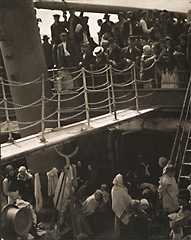Curriculum Materials: Art in America
|
|
Image 17 Alfred Stieglitz Questions: |
The Steerage
In 1907 Stieglitz sailed to Europe on the luxury liner Kaiser Wilhelm II. Below the first-class upper deck, he saw passengers crowded into the less costly steerage level below. The steerage was divided into an upper and lower deck joined by a narrow stairway.
Stieglitz recalled:
The scene fascinated me: A round straw hat; the funnel leaning left, the stairway leaning right; the white drawbridge, its railings made of chain; white suspenders crossed on the back of a man below; circular iron machinery; a mast that cut into the sky, completing a triangle. I stood spellbound for a while. I saw shapes related to one another - a picture of shapes, and underlying it, a new vision that held me: simple people; the feeling of ship, ocean, sky; a sense of release that I was away from the mob called "rich." (Quoted in Dorothy Norman, Alfred Stieglitz: An American Seer (Middleton, N.Y.: Aperture, 1973) p. 76.)
Stieglitz ran to get his camera, hoping that the man with the white hat, the man in suspenders, and a seated woman with a child below would not move. He felt that the perfection of the COMPOSITION would be lost if those key elements changed. Luckily, they remained in position and he took his photograph.
Stieglitz made this print of The Steerage for his avant-garde publication Camera Work, in 1911, using a specialized ink-printing process called PHOTOGRAVURE. The repeated circles, triangles, and rectangles that captivated him structure the photograph. The sunlit bridge provides a bold diagonal that visually connects the distinctively different upper and lower decks. The upper group consists primarily of darkly dressed men, while the lower crowd is made up mostly of women and children wearing lighter colors. The inactivity of the standing group above contrasts with the active lines of the flowing garments, the makeshift clothes line, and the movement of figures below.
The Steerage is the photograph
Stieglitz said he would want to
represent him if he could choose only one. He felt that this
spontaneous photograph perfectly captured related shapes as
well as human feelings.
|
|
